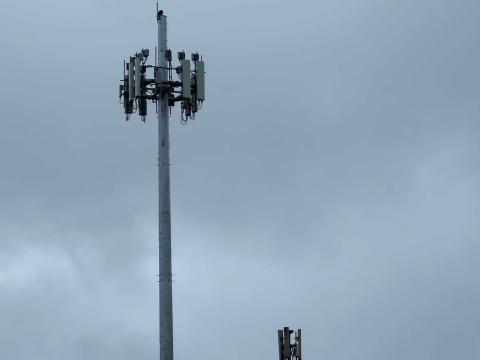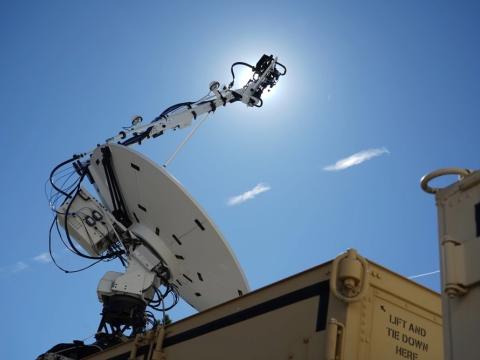Networking Moves Into the High Frontier
Optical information switching technology and wideband ground terminals push network-centric warfare into orbit.
An advanced satellite communications program will use lasers and Internet routing technology to provide future warfighters with high-bandwidth connectivity. The lasers will link orbiting spacecraft directly with command centers, reconnaissance platforms and each other. By switching to light-based transmission, the system will free vital radio spectrum for a family of lightweight tactical terminals designed for mobile, over-the-horizon wideband communications.
Connectivity is a hallmark of network-centric warfare. By sharing data from diverse sources such as sensors and battlefield information systems, units greatly enhance their situational awareness and ability to coordinate with other widely dispersed forces. However, recent operations have exposed a need for a mobile, beyond-line-of-sight communications capability.
The Transformational Communications MILSATCOM (TCM) program seeks to develop new technologies for the next generation of communications satellites and groundstations. Administered by the U.S. Air Force Space and Missile Systems Center, Los Angeles Air Force Base, the program awarded $472 million in January to two teams. Led by The Boeing Company and Lockheed Martin, the teams will conduct initial risk reduction demonstrations and system studies. At the end of 27 months, the winning contractor will undertake a full-scale development program to build the satellites and terrestrial infrastructure. The first spacecraft are scheduled to launch in late 2011.
The TCM program is built around three core technologies, explains Richard Skinner, vice president of Lockheed Martin’s transformational communications division, Sunnyvale, California. These are Internet protocol in space, communications on-the-move and laser-based communications.
Although military and commercial satellites have data services, their connectivity is limited because they must link to ground terminals. While this arrangement is useful if the intended users are connected through that specific terminal, additional equipment and links are required to reach remote or mobile sites, Skinner observes. Current satellite communications systems also operate on a circuit-switched method that reduces the number of accessible information sources. These limitations place a burden on tactical units because the units must access situational data from many sources. “What you want to have is a communications functionality that lets you establish a link with anybody who has information and the proper security credentials,” he says.
This networking capability can be achieved by placing routers aboard satellites. The equipment allows interconnectivity because users can access information through other satellites, the U.S. Defense Department infrastructure or commercial databases via gateways into the civilian Internet.
The second technology being developed through TCM is over-the-horizon communications on the move. Skinner notes that this capability exists, but it is not very efficient. Current on-the-move communications systems either operate at low bandwidth through the military’s ultrahigh frequency satellite system or at very high bandwidth on certain large, expensive platforms such as Air Force One.
Because of these constraints, battlefield command and control vehicles do not have wideband satellite communications, Skinner says. This lack of access affects units below brigade size because they do not have the same level of situational awareness. These limitations surfaced during operation Iraqi Freedom when mobile units lost connectivity with their command elements, he explains.
The TCM will provide units with wideband communications to access imagery, intelligence databases, videoconferencing tools and other types of collaborative applications. The envisioned network will be protected against jamming and other information-warfare-based attacks while providing users with all the access they require. These demands make the TCM system different from commercial and military satellite systems because, although constellations such as MILSTAR are hardened against jamming and data-based attacks, Skinner maintains that they cannot network with tactical users using remote terminals.
The third major technology is the use of lasers to connect satellites and groundstations. Skinner notes that this will apply only to major groundstations and surveillance and reconnaissance platforms such as Global Hawk unmanned aerial vehicles (UAVs). This light-based approach is necessary because the military has run out of spectrum for high-bandwidth communications. “We don’t have the radio frequency spectrum to provide the hundreds of megabits or even gigabits of capacity that future technologies need,” he says.
Lasers permit large amounts of data to be transmitted while freeing radio frequency spectrum for mobile and tactical users. The satellites will use lasers to communicate with each other, enabling direct connections back to databases and servers in the United States. This high-bandwidth capability also permits systems such as space-based radar or UAVs with hyperspectral sensors to stream volumes of real-time data directly to commanders and analysts.
The lasers will allow more users to share bandwidth within the constraints of the Defense Department’s spectrum allocations, Skinner says. This freedom permits tactical users to access more spectrum through a family of ubiquitous ground terminals that are a key part of the TCM program’s ground component. “Rather than having a few hundred users with big, expensive satellite terminals, we will support thousands of users with small terminals,” he predicts.
These terminals for air and ground units will feature small, lightweight antennas. Both Boeing and Lockheed Martin are developing tactical over-the-horizon systems as part of their TCM program packages. The goal is a satellite dish that is one foot in diameter and capable of receiving megabits of data, Skinner says. The terminals will weigh roughly 100 to 120 pounds. He notes that this may resemble the single channel anti-jam manportable system currently being used to link to MILSTAR satellites.
Communications coverage will be provided through a satellite constellation in geosynchronous orbit. Between three and five spacecraft can cover most of the populated areas of the planet from the equator, says Skinner. However, the program has an option for a second constellation in a polar orbit. He explains that, while geosynchronous satellites can cover everything on the planet between 70 degrees north and 70 degrees south latitude, this arrangement does not provide dependable coverage over the extreme Northern or Southern hemispheres. This deficiency affects systems such as the future National Missile Defense interceptors, which will be based in Alaska, and offers no coverage for the shortest air routes to Asia and Europe, which cross over the North Pole, he says.
The added constellation also would provide the Defense Department with complete global coverage—something no U.S. military satellite system has ever achieved, Skinner maintains. This type of planetary service is currently offered only by commercial systems such as Iridium and Globalstar (see page 31), he says.
Skinner notes that the TCM program extends network-centric warfare into space. “It’s about making a communications system that works the same way that we want to fight in the future, with the individual actor in the battlespace being able to reach out and grab whatever information he or she needs to fulfill a mission,” he offers.
Networked satellites will permit the military to provide more efficient communications coverage for widely dispersed forces. Skinner notes that two satellites link U.S. forces in Iraq. One spacecraft is located over the Indian Ocean, and the other is stationed over the Atlantic Ocean. However, if it became necessary to share data between both satellites, a downlink and a ground-based switchboard would be required.
This complexity extends to tactical over-the-horizon communications as well. Even messaging between relatively close units requires bouncing signals multiple times off of a satellite, using twice as many resources to send the transmission, Skinner says. The TCM program reduces this process to a single hop because the spacecraft will carry Internet protocol routers. “The big advantage is that a terminal on the ground just needs one uplink and one downlink to a single satellite,” he explains. Once users are connected to the satellite infrastructure and its supporting ground systems, they can access any other users or data required to accomplish their mission.
To define how this future network will operate, the Air Force launched the transformational communications MILSATCOM mission operations system (TMOS) as part of the TCM program. TMOS will provide network management and control for the space segment and the ground terminals, explains Martin Amen, senior director of Northrop Grumman Mission System’s defense mission division, Reston, Virginia. This effort will study and provide recommendations before building the TMOS network segment. The protocols will define how the network operates and specify rules for satellite and groundstation manufacturers to follow.
Other networking issues involve adapting commercial Internet approaches to military systems, says Christopher Wasser, a senior technical director with Northrop Grumman mission systems. He notes that the protocol will standardize how resources are allocated on the network because civilian systems do not have to reserve network access for life-critical communications dealing with maneuver or force protection issues. These communications must be given consistent priority throughout the entire network. “It would be terrible if a high-priority terrestrial message had to wait five minutes as soon as it went to the satellite. It’s not high priority any more if it’s not high priority from the sender to the receiver,” he says.
Simulation is another important tool supporting the standards. The system will run continuous diagnostic simulations to monitor network traffic dynamics and predict changes in use and connectivity across the network. “You need to make sure that it does not cause ripple effects that impact on other important communications,” explains Wasser.
But extending the Internet into space creates new challenges. The architecture of the Internet protocol has some features that are both beneficial and detrimental for use across satellites, Wasser says. One issue is latency, which is the time it takes a message to be transmitted to a geosynchronous satellite and back to Earth. Weather is another factor affecting transmission. A variety of atmospheric conditions can impede a message—everything from clouds and rain to the sun’s position or the user’s geographic location. The network must take these considerations into account automatically and compensate for them, with both satellite and terminal monitoring the quality of the link, he says.
The TCM program also will develop a new system of standardization for satellite communications. Such coordination is necessary because the space industry grew up in an era when the only standards were military, Skinner explains. After space services became commercialized, these particular standards became unique to the service and hardware providers. “It’s very important that we get it right in terms of being able to plug those applications into the system. Of course we don’t really want to reinvent things that smart people have already defined. We just want to extend them or modify them to operate in the TCM environment,” he says.




Comments